 When my children attended St. Albans School in Washington, DC, October 4 was a big day for them. In our house we knew it as the day that you brought your dog to school to get blessed. What we didn’t know, or appreciate, was that it was the Feast Day for St. Francis of Assisi.
When my children attended St. Albans School in Washington, DC, October 4 was a big day for them. In our house we knew it as the day that you brought your dog to school to get blessed. What we didn’t know, or appreciate, was that it was the Feast Day for St. Francis of Assisi.
I only attended the animal blessing once, but it was memorable. Precious school aged kids with their even more precious cargo of dogs (mostly golden retrievers), cats, hamsters and the occasional iguana would parade up the aisle of the little chapel and receive their blessing. It was a wonderful celebration for the entire family.
In the time that we have owned and managed our little agriturismo, located in the shadow of the city of Assisi, just around the corner from a shrine known as the piandarca where Francis is reputed to have delivered his sermon to the birds, we have gotten to know and appreciate much about this revered saint. And so yesterday, on his Feast Day we and our band of guests made a pilgrimage to the most logical place possible to celebrate his life. The basilica of Santa Maria degli Angeli, an enormous church with an even more enormous dome that is visible for miles across the Umbrian valley that we call home. Here, housed within the church, directly under the dome is a small building, the porziuncola or “little portion” where Francis lived and built his order of frati minori – the religious order better known as the Franciscans. It is an amazing sight, whether or not you know or appreciate St. Francis – a church within a church. Each time we visit I make sure to go inside the porziuncola with its 14th century frescos, just to make sure there isn’t another church inside it. There isn’t. It’s usually just full of pilgrims.
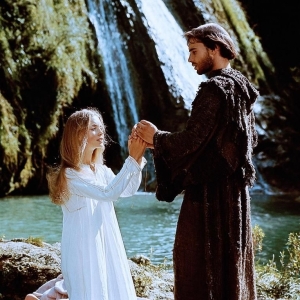 Two days prior to St. Francis Feast Day (the Feast of the Guardian Angels, if you care) we began our group’s St. Francis education with a walking tour of Assisi. Actually this group had quite a good grounding in St. Francis, with several of them having had quite rigorous religious training and upbringing. And of course most of them had watched the Zeffirelli film Brother Sun, Sister Moon, a decidedly 70’s styled movie chronicling the life of St. Francis and St. Claire. The point is that they were not Francis novices.
Two days prior to St. Francis Feast Day (the Feast of the Guardian Angels, if you care) we began our group’s St. Francis education with a walking tour of Assisi. Actually this group had quite a good grounding in St. Francis, with several of them having had quite rigorous religious training and upbringing. And of course most of them had watched the Zeffirelli film Brother Sun, Sister Moon, a decidedly 70’s styled movie chronicling the life of St. Francis and St. Claire. The point is that they were not Francis novices.
But there is nothing like walking around Assisi, literally in the footsteps of Giovanni Bernardone (his given name) to inspire you. So for two hours we followed our guide, himself a Franciscan (in name, not in creed – his name is Francesco) and learned and began to appreciate the incredibly radical break and modern thinking that young Francis represented. Heretical practices like serving the poor and unfortunate, finding value and meaning in the here and 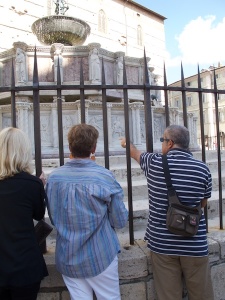 now, respecting the planet and its inhabitants, human and otherwise, pursuing peace. And as we walked in the town he spurned and which has re-adopted him, you begin to appreciate how what we think, what we believe can be traced back to this young maverick.
now, respecting the planet and its inhabitants, human and otherwise, pursuing peace. And as we walked in the town he spurned and which has re-adopted him, you begin to appreciate how what we think, what we believe can be traced back to this young maverick.
Two days later, in nearby Perugia, the city-state that the pre-saintly Francis went off into battle against, dreaming of glory on the battlefield but ending in a jail cell that would rob him of his youth, innocence and health, we again communed with our Franciscan guide. Here we learned of the power and prestige of Perugia, Franceso’s home town. We learned of its Etruscan beginnings, its Roman past, its medieval rise and its renaissance glory, ending in its slow, gradual demise. It is a hauntingly beautiful city, spread out over a series of hills, built and rebuilt upon itself, marking its history with glorious monuments such as its medieval fountain, Etruscan walls and renaissance cathedral.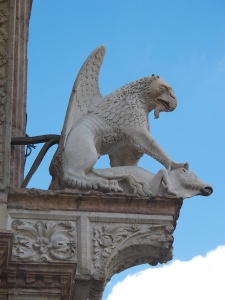
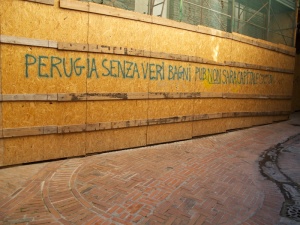 But even in Perugia, across the plain from Assisi which is visible as a gleaming white city, not quite on a hill but on the slopes of a hill, Assisi and St. Francis are impossible to escape. The two cities are jointly competing to be chosen as the European capital of culture in 2019, a periodic designation that is a source of pride and tourist revenue for the lucky winner. Apparently a local movement believes that culture cannot be claimed where there are no public toilets, and we would tend to agree. But perhaps the city fathers just need to communicate their presence better.
But even in Perugia, across the plain from Assisi which is visible as a gleaming white city, not quite on a hill but on the slopes of a hill, Assisi and St. Francis are impossible to escape. The two cities are jointly competing to be chosen as the European capital of culture in 2019, a periodic designation that is a source of pride and tourist revenue for the lucky winner. Apparently a local movement believes that culture cannot be claimed where there are no public toilets, and we would tend to agree. But perhaps the city fathers just need to communicate their presence better.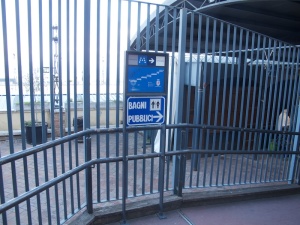
But back to St. Francis. It is St. Francis Feast Day and the entire Umbrian valley is filled with tourists and pilgrims who want to celebrate the day close to the source. Even Perugia, normally a popular tourist spot, seems crowded and bursting at the seams with tourists. And as we arrive in Santa Maria degli Angeli, the late afternoon sun low on the horizon, the scene outside the basilica is mobbed. We discharge our passengers just outside the entrance and improbably (thank you St. Francis) I find a parking space across the street. Inside the basilica, the seventh largest church in the Catholic world, there is a noticeably larger crowd with a line to enter the porziuncola. A large platform has been erected in front of the altar and television monitors have been set up to permit the faithful to witness the special mass that will take place later.
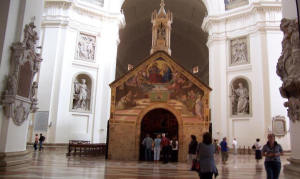 We line up in front of the porziuncola and after being hushed by a nun who doesn’t appreciate my amateur tour guiding, I enter the little building, the little portion that eight hundred years ago was home to a young rebel and his followers who sought not to change the world but to return to a way of life they thought was as self evident as it was simple. And on this St. Francis Feast Day it is nice to be reminded of that message.
We line up in front of the porziuncola and after being hushed by a nun who doesn’t appreciate my amateur tour guiding, I enter the little building, the little portion that eight hundred years ago was home to a young rebel and his followers who sought not to change the world but to return to a way of life they thought was as self evident as it was simple. And on this St. Francis Feast Day it is nice to be reminded of that message.
Ci vediamo!
Bill and Suzy


About The Author
Related Posts
Home. That's what Cannara has become. Home.Read more »
We're back home in Cannara after an overnight in Florence to pick up our twin…